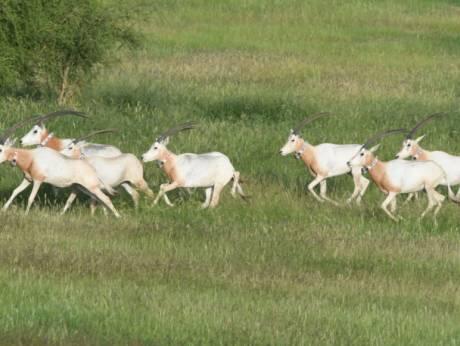After 25 years of no sightings due to extinction, the scimitar horned oryx have finally returned to the wild in Chad’s Sahelian grasslands, the last known place for them to have been sighted, the Environment Agency – Abu Dhabi (EAD) announced last week.
The reintroduction of the animals into the wild — numbering 25 — comes as part of an EAD-led programme that is working on releasing 300 to 500 wild oryx in total over the next five years.
The 25 scimitar horned oryx were first transported to Africa back in March and were later fitted with GPS collars to track their movements.
Speaking on the monumental conservation achievement, Razan Khalifa Al Mubarak, EAD’s secretary-general, said: “Since 2000 the scimitar-horned oryx has been classified as ‘Extinct in the Wild’ by the International Union for the Conservation of Nature (IUCN) Red List. There have been no sightings for more than 25 years due to unregulated hunting, loss of habitat and lack of resources for conservation. The [EAD] programme to reinstate a viable population of this once extinct in the wild majestic creature in its home range of Chad is a dream come true. This initial release will provide us with invaluable data to develop a self-sustaining wild population.
“The project, which is part of EAD’s long-term commitment to conserve biodiversity for future generations, is inspired by the legacy and efforts of the late Shaikh Zayed [Bin Sultan Al Nahyan] to protect endangered species and rehabilitate them in their natural habitat,” she added.
Dr Shaikha Salem Al Daheri, executive director, Terrestrial and Marine Biodiversity Sector at the EAD, explained how the animals would be tracked, and said that the animal’s location would be received twice a day.
“In July, EAD, Sahara Conservation Fund, Smithsonian Conservation Biology Institute (SCBI) and Biology Institute (SCBI) and Zoological Society of London teams fitted the scimitar-horned oryx with GPS collars. Twice a day the team receives the position of every animal collared. Based on these coordinates, field staff can monitor the population.
“The three- to four-year life span of the collars, with an ability to remotely release and programme them, will help rangers to learn more about movement, behaviour and mortality and know more about the ecology of the species in the wild. Overall, the data will tell scientists where they go seasonally, how far they travel, whether they stay together or disperse into different social groups, and even if a poacher has taken an animal,” she added.
Al Daheri said that the initial tracking showed that the animals were comfortably adjusting to their surroundings.
“So far our initial reports shows that a group of 19 animals, who had have ranged over 30km from the released site, are together and with green vegetation and water. They seem alert, healthy, calm and well-adjusted, acclimatised to their new surroundings,” she said.
Steve Monfort, the John and Adrienne Mars director of the SCBI, said the GPS tracking devices and its data would provide key valuable research analysis for conservationists.
“This is an epic homecoming for this majestic species and a significant step forward for wildlife conservation. We know so little about this species in the wild and the data we’re collecting will tell us where these animals are — and what’s going on with them — in near real-time over a number of years. We’re essentially opening up a window that will help us understand how and why individuals move across the landscape, and allow us to monitor each individual in a way that was never before possible.”
Source: Gulf News











